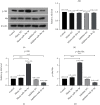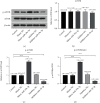MicroRNA-29a-3p Regulates SH-SY5Y Cell Proliferation and Neurite Growth through Interaction with PTEN-PI3K/AKT/mTOR Signaling Pathway
- PMID: 35958280
- PMCID: PMC9359856
- DOI: 10.1155/2022/8151161
MicroRNA-29a-3p Regulates SH-SY5Y Cell Proliferation and Neurite Growth through Interaction with PTEN-PI3K/AKT/mTOR Signaling Pathway
Retraction in
-
Retracted: MicroRNA-29a-3p Regulates SH-SY5Y Cell Proliferation and Neurite Growth through Interaction with PTEN-PI3K/AKT/mTOR Signaling Pathway.Dis Markers. 2023 Jul 19;2023:9824132. doi: 10.1155/2023/9824132. eCollection 2023. Dis Markers. 2023. PMID: 37502599 Free PMC article.
Abstract
The effects of microRNA-29a-3p in the proliferation process of nerve cells are unclear. The purpose of this study is to delve into the regulatory role of microRNA-29a-3p, via interaction with phosphatase and tension homolog (PTEN), in the SH-SY5Y cell proliferation process. Different expressions of microRNA-29a-3p in the SH-SY5Y cells were constructed by transfected miRNA-29a-3p mimic and inhibitor. The effects of cell transfection and the mRNA expressions of PTEN, Akt, and mTOR were detected by qPCR. The expressions of PTEN, Akt, and mTOR protein and the phosphorylation levels of Akt and mTOR were examined using Western blotting. Nerve cell proliferation activity and neurite length of each group were measured and examined by the use of 3-(4, 5-dimethyl-2-thiazolyl)-2, 5-diphenyl-2Htetrazolium bromide (MTT), and morphological examination. We observed that the levels of PTEN mRNA and protein were distinctly decreased in the microRNA-29a-3p mimic group, but the expressions of the phosphorylated Akt and mTOR mRNA and protein were distinctly upregulated. In the transfected miRNA-29a-3p inhibitor SH-SY5Y cells, the expressions of miRNA-29a-3p were significantly suppressed; however, the expressions of PTEN gene and protein were significantly enhanced. The expressions of phosphorylated Akt and mTOR in the downregulated microRNA-29a-3p group distinctly were suppressed. The SH-SY5Y cell proliferation activity and neurite length in the upregulated microRNA-29a-3p group increased significantly. Our findings revealed that microRNA-29a-3p could enhance the proliferation activity of SH-SY5Y cells and promote neurite growth by inhibiting the expression of PTEN and regulating PI3K/Akt/mTOR signaling pathway.
Copyright © 2022 Wansheng Gao et al.
Conflict of interest statement
All the authors declare no conflict of interests.
Figures





Similar articles
-
SNHG1 promotes MPP+-induced cytotoxicity by regulating PTEN/AKT/mTOR signaling pathway in SH-SY5Y cells via sponging miR-153-3p.Biol Res. 2020 Jan 6;53(1):1. doi: 10.1186/s40659-019-0267-y. Biol Res. 2020. PMID: 31907031 Free PMC article.
-
miR-29a promotes pathological cardiac hypertrophy by targeting the PTEN/AKT/mTOR signalling pathway and suppressing autophagy.Acta Physiol (Oxf). 2019 Oct;227(2):e13323. doi: 10.1111/apha.13323. Epub 2019 Jul 1. Acta Physiol (Oxf). 2019. PMID: 31162869
-
Neuroprotection of miR-214 against isoflurane-induced neurotoxicity involves the PTEN/PI3K/Akt pathway in human neuroblastoma cell line SH-SY5Y.Arch Biochem Biophys. 2019 Dec 15;678:108181. doi: 10.1016/j.abb.2019.108181. Epub 2019 Nov 5. Arch Biochem Biophys. 2019. PMID: 31704096
-
miR-29a-3p compositely regulates the COL6A6/PTEN-PI3K/Akt/CUX1 feedback loop to participate in the proliferation and invasion of pituitary adenomas.J Mol Histol. 2025 May 27;56(3):172. doi: 10.1007/s10735-025-10436-0. J Mol Histol. 2025. PMID: 40419838 Free PMC article.
-
Muscleblind-like 1 antisense RNA 1 inhibits cell proliferation, invasion, and migration of prostate cancer by sponging miR-181a-5p and regulating PTEN/PI3K/AKT/mTOR signaling.Bioengineered. 2021 Dec;12(1):803-814. doi: 10.1080/21655979.2021.1890383. Bioengineered. 2021. PMID: 33648424 Free PMC article.
Cited by
-
The molecular genetics of PI3K/PTEN/AKT/mTOR pathway in the malformations of cortical development.Genes Dis. 2023 Jul 16;11(5):101021. doi: 10.1016/j.gendis.2023.04.041. eCollection 2024 Sep. Genes Dis. 2023. PMID: 39006182 Free PMC article. Review.
-
Retracted: MicroRNA-29a-3p Regulates SH-SY5Y Cell Proliferation and Neurite Growth through Interaction with PTEN-PI3K/AKT/mTOR Signaling Pathway.Dis Markers. 2023 Jul 19;2023:9824132. doi: 10.1155/2023/9824132. eCollection 2023. Dis Markers. 2023. PMID: 37502599 Free PMC article.
-
miR-28-5p's Targeting of GAGE12I Inhibits Proliferation, Migration, and Invasion of Gastric Cancer in Vitro.Evid Based Complement Alternat Med. 2022 Sep 30;2022:6946051. doi: 10.1155/2022/6946051. eCollection 2022. Evid Based Complement Alternat Med. 2022. Retraction in: Evid Based Complement Alternat Med. 2023 Jun 21;2023:9819238. doi: 10.1155/2023/9819238. PMID: 36212971 Free PMC article. Retracted.
-
GDNF and miRNA-29a as biomarkers in the first episode of psychosis: uncovering associations with psychosocial factors.Front Psychiatry. 2024 Apr 2;15:1320650. doi: 10.3389/fpsyt.2024.1320650. eCollection 2024. Front Psychiatry. 2024. PMID: 38645418 Free PMC article.
-
[Aumolertinib inhibits proliferation, invasion and migration and promotes apoptosis of neuroblastoma cells by downregulating MMP2 and MMP9 expression].Nan Fang Yi Ke Da Xue Xue Bao. 2023 Sep 20;43(9):1493-1499. doi: 10.12122/j.issn.1673-4254.2023.09.06. Nan Fang Yi Ke Da Xue Xue Bao. 2023. PMID: 37814863 Free PMC article. Chinese.
References
Publication types
MeSH terms
Substances
LinkOut - more resources
Full Text Sources
Medical
Research Materials
Miscellaneous

